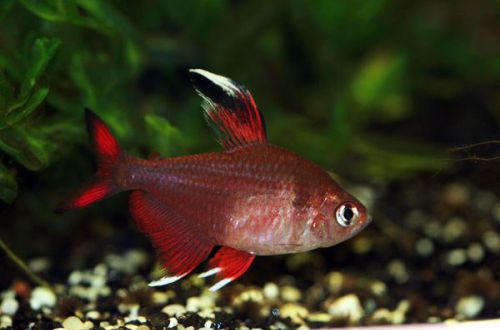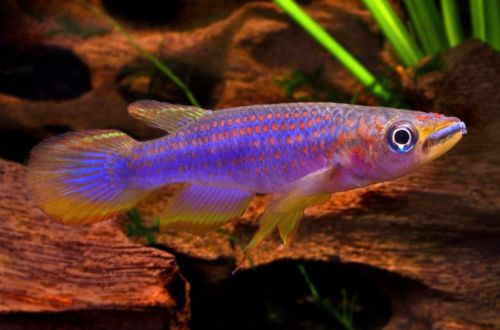
Pink Tetra
Pink Tetra or Ornatus pink, scientific name Hyphessobrycon rosaceus, belongs to the Characidae family, an excellent addition to other peaceful aquarium inhabitants. In body shape and coloration, it is very similar to the Exquisite Tetra, so they are often confused and in pet stores both species can be sold together under the same name.

Habitat
This species is widely distributed throughout the Amazon basin (South America). They prefer small tributaries of large rivers with a calm flow, flowing in the substrate of the rainforest. The water of these rivers is silty, muddy, Tetras feed mainly on small invertebrates.
Description
The body shape is classic for small tetras, it has a magnificent pink color with black markings on the fins, the tips of which are white. The Exquisite Tetra also has a similar pattern and color from soft pink to deep coral, but the color saturation is less, so it looks paler.
Food
Ornatus pink is an omnivorous species, but you should not feed it with anything. Fish need a balanced diet of quality feed. They have a fairly high need for vitamins, so healthy food should dominate their diet (60-80% of all food). They prefer live food such as bloodworms or daphnia, but will also eat soft plants.
Maintenance and care
Tetra is sensitive to water quality, a productive filter is a key condition for successful breeding. The streams of water leaving the filter should be directed towards the aquarium wall to prevent excessive water movement. Lighting should be subdued, do not use powerful light sources. Other necessary equipment consists of a heater and an aerator.
In the design, use dense thickets of plants located along the side and back walls of the aquarium. As a soil, river sand is optimal. To simulate cloudy water, use dry leaves, which are replaced every two weeks, and a bag of peat. Buy peat in pet stores, specially processed and prepared for placement in aquariums, in no case take it from swamps.
Social behavior
In a well-equipped aquarium, the Pink Tetra will be active and show all its beauty. It is a schooling species, must be kept in a group of at least 6 individuals, feels great with other close relatives such as: Black Tetra, White Tetra, Red-spotted Tetra, Exquisite Tetra, etc. Noisy fish are bad neighbors, so keep them needed only with peaceful and non-predatory species.
Breeding / breeding
Breeding Ornathus rosea is a very complicated process and is hardly within the power of a novice aquarist. However, healthy pairs usually breed easily and quickly when kept in soft water and slightly elevated temperatures (around 26°C). The male and female should be isolated, ideally in a separate tank. The female lays her eggs on thin leaves or plant stems. The pair should be immediately removed from the aquarium. The fry go to free swimming after 3-4 days. Partially the water is replaced with fresh daily. Care must be taken that the fry are not lost during this process.
Diseases
This species is extremely hardy and is not prone to disease, provided that the aquarium is well maintained and cared for. Read more about the symptoms and methods of treating diseases in the section “Diseases of aquarium fish”.





